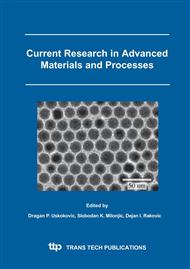p.513
p.519
p.525
p.531
p.537
p.543
p.549
p.555
p.561
Kinetics of Interaction between Fullerol C60(OH)24 and Polyacrylic Hydrogels
Abstract:
In this paper kinetics of binding of fullerol to polyacrylic hydrogel at different temperatures, 298, 308 and 318 K, has been investigated. Time dependences of specific capacity of fullerol binding to hydrogel at defined temperatures are determined. Kinetic curves of specific binding capacity of fullerol for hydrogel are described by equations: t x k t x k x max 1 2 max 1 1+ = and x=k2tn. Rate constants k1 and k2 of the specific fullerol binding capacity at various temperatures are determined. Based on changes in constants k1 and k2 with temperature, kinetic parameters of the investigated process are calculated. Also, due to a great difference in values of kinetic parameters k1 and k2 obtained by varying the temperature, kinetic parameters are determined by using Friedman’s isoconversion method. The values of kinetic parameters based on temperature changes in k2 correspond to the values of kinetic parameters for 9 . 0 » a , while the values of kinetic parameters calculated according to the temperature change in k1, correspond to the Ea values. According to the obtained results it is concluded that the investigated process is controlled by diffusion.
Info:
Periodical:
Pages:
555-560
Citation:
Online since:
September 2005
Authors:
Keywords:
Price:
Сopyright:
© 2005 Trans Tech Publications Ltd. All Rights Reserved
Share:
Citation:


